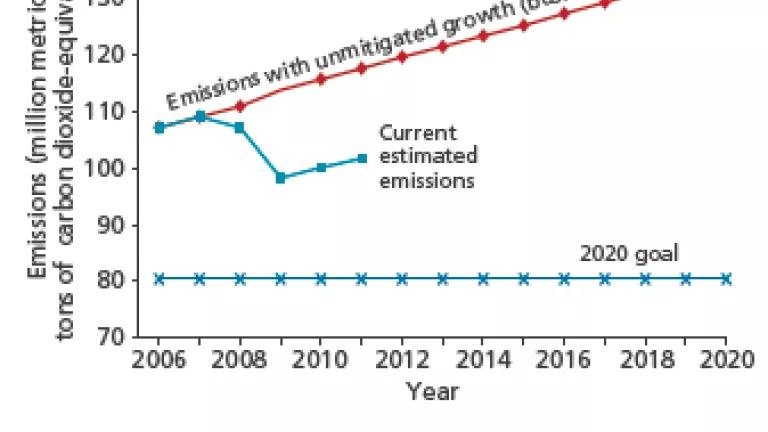
My friend Robert Puentes has started a drumbeat on Twitter with the hashtag #CanDoStates about states moving ahead on transportation in contrast to a federal government stuck in partisan doldrums. I’m proud to say that my little home state of Maryland has just one-upped other states in transportation leadership, and is truly deserving of the “can-do” nickname. It did this by boldly going where few states, and certainly not the federal government, have gone: Using a comprehensive suite of transportation policy tools, not just cool car technology, to cut carbon pollution.
A couple of weeks ago Governor Martin O’Malley rolled out a new 265-page climate change plan, detailing the state’s framework for cutting heat trapping pollution 25 percent by 2020, and included thoughtful and detailed transportation ideas.
The goal for cleaning up this problem is quiet aggressive, and every sector does its part under Maryland’s plan. Graphs from the plan show transportation's role in the cleanup:
Enhanced technological measures account for more than 60 percent of the total emission reductions from transportation. In addition to Maryland initiatives, our state relies heavily on national programs that improve fuel economy for onroad vehicles, both light-duty (e.g., cars, SUVs, pickups, vans) and medium- and heavy-duty (e.g., semis, delivery trucks) and that require increasing use of renewable fuels.
What’s really interesting are the measures that complement technological improvements with delivery of non-solo-driving transportation choices and incentives to use them. There’s some cutting-edge stuff in here which accounts for almost 40 percent of the transportation pollution cuts when enhanced:
- Transportation infrastructure includes major new transit lines including the long-awaited Purple Line for Metro*, the east-west Red Line in Baltimore City**, and a “Transitway” connecting a Metro stop to an employment center in suburban Montgomery County with bus rapid transit. Major funding for these initiatives was secured earlier this year in a major transportation law which raises gas taxes and generates $4.4 billion in new support for transportation in the state. The plan also specifies various tools for ensuring higher ridership on transit, including the Commuter Choice program, more transit-oriented development, and guaranteed rides home for commuters who use transit. More enhanced programs to reduce solo driving include ridesharing promotion including via apps and social marketing, real-time transit information technologies, alternative work schedules and various economic incentives (e.g., greater use of transit tax benefits and reduced transit fares). The plan also includes “intercity” transportation improvements such as investment in MARC rail service connecting northern Maryland, Baltimore and Washington, D.C. and parts in between, as well as improvements in freight rail capacity. Both of these could reduce road traffic on often-congested I-95. MDOT would also deliver bicycle and pedestrian enhancements, bike racks on transit vehicles, new bike lanes and paths as well as Maryland’s portion of the “East Coast Greenway.”
- Pricing includes more electronic toll collection, and possible enhancements including a possible systems benefit charge (borrowing an idea for utilities, in which consumers are charged and the revenue goes to activities that help low-income consumers and improve efficiency of transportation to reduce emissions), a higher gasoline tax (although Maryland just enacted one), better-managed parking to reduce incentives to drive (for example, by allowing employees to “cash out” their workplace parking benefit), and a commitment to “explore…options” for congestion pricing. The plan also includes a lengthy section about “Pay-As-You-Drive” (PAYD) auto insurance, which would deliver choices such as Progressive Insurance’s “MyRate” program which tie rates to number of miles driven. Maryland drivers would have more such options, and more of them would participate. Having studied this measure, I agree it could reduce pollution as consumers in search of lower premiums drive less.
- Enhanced land use policy ideas in the plan include “developing incentives and requirements for development projects and regional land use patterns that achieve land use/location efficiency with regard to transportation.” (p. 211) While some tools for this work are already on the books, new policies are also in order according to the plan. The plan also explicitly mentions SB 375 as a potential model for new policy, which it will investigate thoroughly between now and 2015. If Maryland wants to retain the “can-do” leadership mantle that’s exactly what we should do. It’s paying off in southern California, a onetime cradle of suburban sprawl. The plan also describes use of priority funding areas, a 20-year-old growth management tool that requires Maryland’s 23 counties to designate growth areas and commits state funding to those areas (and not those outside of their boundaries). This potentially powerful tool could help reduce pollution. So could the adoption of serious and substantive long-term greenhouse gas emission reduction targets by the two metropolitan planning organizations in Maryland, the Baltimore Metropolitan Council and the Transportation Planning Board.
There’s a lot to chew on in this plan, and a lot of follow-up needed to implement it. I look forward to working on moving it forward with fellow Marylanders.
*The D.C. Metro is organized like a set of spokes from a hub, which leaves suburb-to-suburb commuters and travelers stranded, the Purple Line would connect spokes in Maryland’s suburbs
**Baltimore has just one long light rail line running north-south, this would add substantially to the system
